Question 1
The following diagram shows part of the graph of `f(x)`.
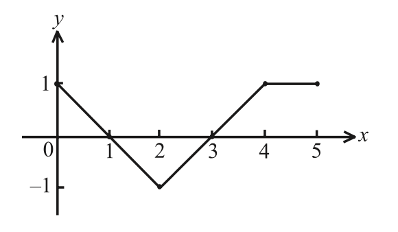
Consider the five graphs in the diagrams labelled A, B, C, D, E below.

(a) Which diagram is the graph of `f(x+2)`?
(b) Which diagram is the graph of `-f(x)`?
(c) Which diagram is the graph of `f(-x)`?
Mark as Complete
Mark Scheme
Question 2
(a) Express `y=2x^2-12x+23` in the form of `y=2(x-c)^2+d`
The graph of `y=x^2` is transformed into the graph of `y=2x^2-12x+23` by the transformations
(b) Write down the value of
(i) `k`;
(ii) `p`;
(iii) `q`.
Mark as Complete
Mark Scheme
Question 3
The graph of `y=f(x)` is shown in the diagram.

(a) On each of the following diagrams draw the required graph.
(i) `y=2f(x)`
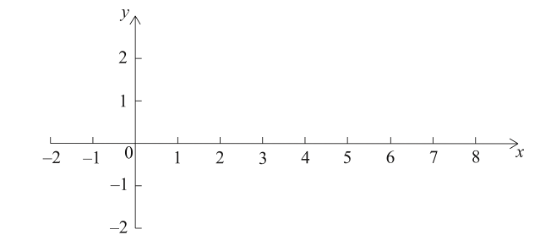
(ii) `y=f(x-3)`

(b) The point `A`(3,`-`1) is on the graph of `f`. The point `A'` is the corresponding point on the graph of `y=-f(x)+1`. Find the coordinates of `A'`.
Mark as Complete
Mark Scheme
Question 4
Let `g(x)=x^2+bx+11`. The point (−1,8) lies on the graph of `g`.
(a) Find the value of `b`.
(b) The graph of `f(x)=x^2` is transformed to obtain the graph of `g`.
Describe this transformation.
Mark as Complete
Mark Scheme
Question 5
The following diagram shows part of the graph of `f` with `x`-intercept (5,0) and `y`-intercept (0,8).
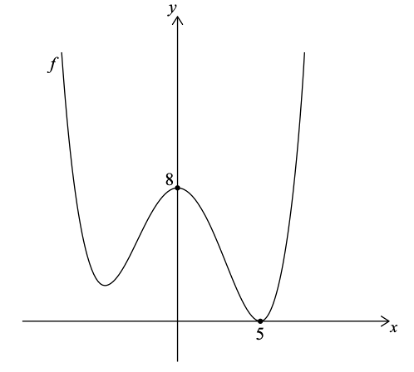
(a) Find the `y`-intercept of the graph of
(i) `f(x)+3`
(ii) `f(4x)`
(b) Find the `x`-intercept of the graph of `f(2x)`.
(c) Describe the transformation `f(x+1)`.
Mark as Complete
Mark Scheme
Question 6
Consider `f(x)=4sin(x)+2.5` and `g(x)=4sin(x-{3pi}/2)+2.5+q`, where `x in RR` and `q > 0`. The graph of `g` is obtained by two transformations of the graph of `f`.
(a) Describe these two transformations.
The `y`-intercept of the graph of `g` is at (0, `r`).
(b) Given that `g(x) >= 7`, find the smallest value of `r`.
Mark as Complete
Mark Scheme
Question 7
Let `f(x) = x^2 − 4x − 5`. The following diagram shows part of the graph of `f`.
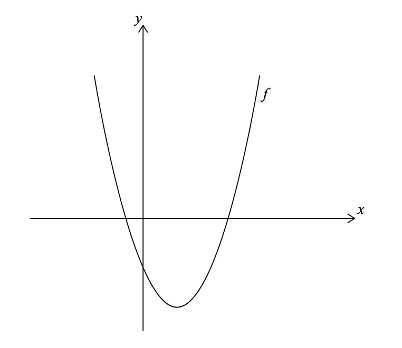
(a) Find the `x`-intercepts of the graph of `f`.
(b) Find the equation of the axis of symmetry of the graph of `f`.
(c) The function can be written in the form `f(x) = (x − h)^2 + k`.
(i) Write down the value of `h`.
(ii) Find the value of `k`.
The graph of a second function, `g`, is obtained by a reflection of the graph of `f` in the `y`-axis, followed by a translation of `((-3),(6))`.
(d) Find the coordinates of the vertex of the graph of `g`.
Mark as Complete
Mark Scheme
Question 8
The following diagram shows the graph of a function `f`, for `-4 <= x <= 2`.

(a) On the same axes, sketch the graph of `f(-x)`.
(b) Another function, `g`, can be written in the form `g(x) = a × f(x + b)`. The following diagram shows the graph of `g`.
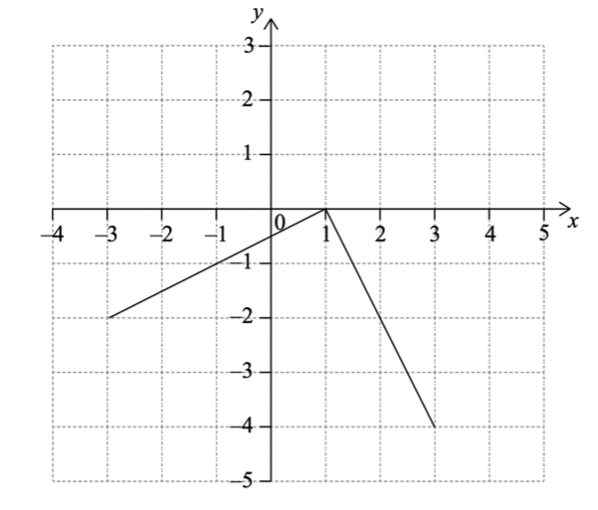
Write down the value of `a` and of `b`.
Mark as Complete
Mark Scheme
Question 9
Let `f'(x)={6-2x}/{6x-x^2}`, for `0 < x < 6`.
The graph of `f` has a maximum point at P.
(a) Find the `x`-coordinate of P.
The `y`-coordinate of P is `ln 27`.
(b) Find `f(x)`, expressing your answer as a single logarithm.
(c) The graph of `f` is transformed by a vertical stretch with scale factor `1/{ln 3}`. The image of P under this transformation has coordinates `(a,b)`.
Find the value of `a` and of `b`, where `a,b in NN`.
Mark as Complete
Mark Scheme
Question 10
Let `f(x)=sin(x+pi/4)+k`. The graph of 𝑓 passes through the point `(pi/4,6)`.
(a) Find the value of `k`.
(b) Find the minimum value of `f(x)`.
Let `g(x) = sin x`. The graph of `g` is translated to the graph of `f` by the vector `((p),(q))`.
(c) Write down the value of `p` and of `q`.
Mark as Complete
Mark Scheme
Question 1
The following diagram shows part of the graph of `f(x)`.

Consider the five graphs in the diagrams labelled A, B, C, D, E below.

(a) Which diagram is the graph of `f(x+2)`?
(b) Which diagram is the graph of `-f(x)`?
(c) Which diagram is the graph of `f(-x)`?
(a) D
(b) C
(c) A
Question 2
(a) Express `y=2x^2-12x+23` in the form of `y=2(x-c)^2+d`
The graph of `y=x^2` is transformed into the graph of `y=2x^2-12x+23` by the transformations
(b) Write down the value of
(i) `k`;
(ii) `p`;
(iii) `q`.
(a) For attempting to complete the square or expanding `y=2(x-c)^2+d`, or for showing the vertex is at (3, 5)
`y=2(x-3)^2+5` (accept `c=3,d=5`)
(b)
(i) `k=2`
(ii) `p=3`
(iii) `q=5`
Question 3
The graph of `y=f(x)` is shown in the diagram.

(a) On each of the following diagrams draw the required graph.
(i) `y=2f(x)`

(ii) `y=f(x-3)`

(b) The point `A`(3,`-`1) is on the graph of `f`. The point `A'` is the corresponding point on the graph of `y=-f(x)+1`. Find the coordinates of `A'`.
(a)
(i)
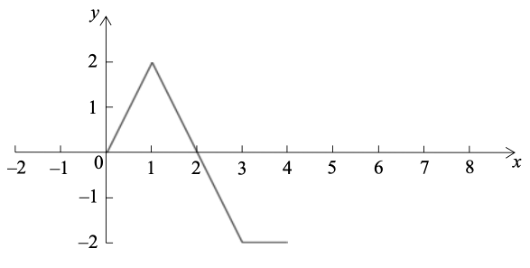
(ii)
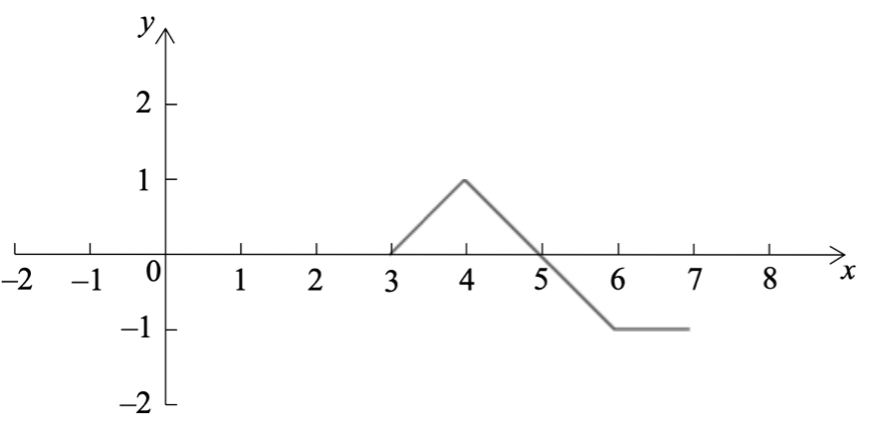
(b) `A'(3,2)` (accept `x=3,y=2`)
Question 4
Let `g(x)=x^2+bx+11`. The point (−1,8) lies on the graph of `g`.
(a) Find the value of `b`.
(b) The graph of `f(x)=x^2` is transformed to obtain the graph of `g`.
Describe this transformation.
(a) valid attempt to substitute coordinates
e.g. `g`(`-`1) = 8
correct substitution
e.g. `(-1)^2+b(-1)+11=8, \ 1-b+11=8`
`b`= 4
(b) valid attempt to solve
e.g. `(x^2+4x+4)+7, h=-4/2, k=g(-2)`
correct working
e.g. `(x+2)^2+7, h=-2, k=7`
translation or shift (do not accept move) of vector `((-2),(7))` (accept left by 2 and up by 7)
Question 5
The following diagram shows part of the graph of `f` with `x`-intercept (5,0) and `y`-intercept (0,8).

(a) Find the `y`-intercept of the graph of
(i) `f(x)+3`
(ii) `f(4x)`
(b) Find the `x`-intercept of the graph of `f(2x)`.
(c) Describe the transformation `f(x+1)`.
(a)
(i) `y`-intercept is 11 (accept (0,11))
(ii) valid approach
e.g. `f`(4 × 0) = `f`(0), recognizing stretch of `1/4` in `x`-direction
`y`-intercept is 8 (accept (0,8))
(b) `x`-intercept is `5/2 \ (=2.5)` (accept `(5/2,0)` or `(2.5,0)`)
(c) correct name, correct magnitude and direction
e.g. name: translation, (horizontal) shift (do not accept move)
e.g. magnitude and direction: 1 unit to the left, `((-1),(0))`, horizontal by −1
Question 6
Consider `f(x)=4sin(x)+2.5` and `g(x)=4sin(x-{3pi}/2)+2.5+q`, where `x in RR` and `q > 0`. The graph of `g` is obtained by two transformations of the graph of `f`.
(a) Describe these two transformations.
The `y`-intercept of the graph of `g` is at (0, `r`).
(b) Given that `g(x) >= 7`, find the smallest value of `r`.
(a) translation (shift) by `{3pi}/2` to the right/positive horizontal direction
translation (shift) by `q` upwards/positive vertical direction
(b) minimum of `4sin(x-{3pi}/2)` is `-`4 (may be seen in sketch)
`-4+2.5+q >= 7`
`q >= 8.5` (accept `q=8.5`)
substituting `x` = 0 and their `q` (= 8.5) to find `r`
`(r=)\ 4sin({-3pi}/2)+2.5+8.5`
`4+2.5+8.5`
smallest value of `r` is 15
Question 7
Let `f(x) = x^2 − 4x − 5`. The following diagram shows part of the graph of `f`.

(a) Find the `x`-intercepts of the graph of `f`.
(b) Find the equation of the axis of symmetry of the graph of `f`.
(c) The function can be written in the form `f(x) = (x − h)^2 + k`.
(i) Write down the value of `h`.
(ii) Find the value of `k`.
The graph of a second function, `g`, is obtained by a reflection of the graph of `f` in the `y`-axis, followed by a translation of `((-3),(6))`.
(d) Find the coordinates of the vertex of the graph of `g`.
(a) valid approach
e.g. `f(x)=0, x^2-4x-5=0`
valid attempt to solve quadratic equation
e.g. factorizing, formula, completing the square
evidence of correct working
e.g. `(x-5)(x+1), x={4+- sqrt{16-4(-5)}}/{2}`
`x=-1, x=5` (accept `(-1,0), (5,0)`)
(b) correct working
e.g. `{-(-4)}/{2(1)},{-1+5}/2`
`x=2` (must be an equation with `x=`)
(c)
(i) `h=2`
(ii) valid approach, e.g. `f(2)`
correct substitution, e.g. `2^2-4(2)-5`
`k=-9`
(d) vertex of `f` is at `(2,-9)`
correct horizontal reflection
e.g. `x = −2, (−2, −9)`
valid approach for translation of their `x` or `y` value
e.g. `x-3,y+6, ((-2),(-9))+((-3),(6))`, one correct coordinate for vertex
vertex of `g` is `(−5,−3)` (accept `x = −5,y = −3`)
Question 8
The following diagram shows the graph of a function `f`, for `-4 <= x <= 2`.

(a) On the same axes, sketch the graph of `f(-x)`.
(b) Another function, `g`, can be written in the form `g(x) = a × f(x + b)`. The following diagram shows the graph of `g`.

Write down the value of `a` and of `b`.
(a)

(b) recognizing horizontal shift/translation of 1 unit
e.g. `b = 1`, moved 1 right
recognizing vertical stretch/dilation with scale factor 2
e.g. `a = 2, y × (−2)`
`a = −2, b = −1`
Question 9
Let `f'(x)={6-2x}/{6x-x^2}`, for `0 < x < 6`.
The graph of `f` has a maximum point at P.
(a) Find the `x`-coordinate of P.
The `y`-coordinate of P is `ln 27`.
(b) Find `f(x)`, expressing your answer as a single logarithm.
(c) The graph of `f` is transformed by a vertical stretch with scale factor `1/{ln 3}`. The image of P under this transformation has coordinates `(a,b)`.
Find the value of `a` and of `b`, where `a,b in NN`.
(a) recognizing `f'(x)=0`
correct working
e.g. `6-2x=0`
`x=3`
(b) evidence of integration
e.g. `int f', int {6-2x}/{6x-x^2}dx`
using substitution
e.g. `int 1/u du` where `u=6x-x^2`
correct integral
e.g. `ln(u) + c, ln(6x − x^2)`
substituting `(3, ln 27)` into their integrated expression (must have `c`)
e.g. `ln(6 × 3 − 3^2) + c = ln 27 , ln(18 − 9) + ln k = ln 27`
correct working
`c = ln 27 − ln 9 = ln 3`
attempt to substitute their value of `c` into `f(x)`
e.g. `f(x) = ln(6x − x^2) + ln 3 = ln(3(6x − x^2))`
(c) `a = 3`
correct working
e.g. `{ln27}/{ln 3}`
correct use of log law
e.g. `{3ln3}/{ln 3},log_3 27`
`b=3`
Question 10
Let `f(x)=sin(x+pi/4)+k`. The graph of 𝑓 passes through the point `(pi/4,6)`.
(a) Find the value of `k`.
(b) Find the minimum value of `f(x)`.
Let `g(x) = sin x`. The graph of `g` is translated to the graph of `f` by the vector `((p),(q))`.
(c) Write down the value of `p` and of `q`.
(a) recognizing shift of `pi/4` left means maximum at 6
recognizing `k` is difference of maximum and amplitude
e.g. `6-1`
`k=5`
(b) evidence of appropriate approach
e.g. minimum value of `sin x` is `−1, −1 + k, f'(x) = 0, ({5pi}/4,4)`
minimum value is 4
(c) `p={-pi}/4,q=5` (accept `(({-pi}/4),(5))`)
Question 1
The following diagram shows part of the graph of `f(x)`.

Consider the five graphs in the diagrams labelled A, B, C, D, E below.

(a) Which diagram is the graph of `f(x+2)`?
(b) Which diagram is the graph of `-f(x)`?
(c) Which diagram is the graph of `f(-x)`?
Question 2
(a) Express `y=2x^2-12x+23` in the form of `y=2(x-c)^2+d`
The graph of `y=x^2` is transformed into the graph of `y=2x^2-12x+23` by the transformations
(b) Write down the value of
(i) `k`;
(ii) `p`;
(iii) `q`.
Question 3
The graph of `y=f(x)` is shown in the diagram.

(a) On each of the following diagrams draw the required graph.
(i) `y=2f(x)`

(ii) `y=f(x-3)`

(b) The point `A`(3,`-`1) is on the graph of `f`. The point `A'` is the corresponding point on the graph of `y=-f(x)+1`. Find the coordinates of `A'`.
Question 4
Let `g(x)=x^2+bx+11`. The point (−1,8) lies on the graph of `g`.
(a) Find the value of `b`.
(b) The graph of `f(x)=x^2` is transformed to obtain the graph of `g`.
Describe this transformation.
Question 5
The following diagram shows part of the graph of `f` with `x`-intercept (5,0) and `y`-intercept (0,8).

(a) Find the `y`-intercept of the graph of
(i) `f(x)+3`
(ii) `f(4x)`
(b) Find the `x`-intercept of the graph of `f(2x)`.
(c) Describe the transformation `f(x+1)`.
Question 6
Consider `f(x)=4sin(x)+2.5` and `g(x)=4sin(x-{3pi}/2)+2.5+q`, where `x in RR` and `q > 0`. The graph of `g` is obtained by two transformations of the graph of `f`.
(a) Describe these two transformations.
The `y`-intercept of the graph of `g` is at (0, `r`).
(b) Given that `g(x) >= 7`, find the smallest value of `r`.
Question 7
Let `f(x) = x^2 − 4x − 5`. The following diagram shows part of the graph of `f`.

(a) Find the `x`-intercepts of the graph of `f`.
(b) Find the equation of the axis of symmetry of the graph of `f`.
(c) The function can be written in the form `f(x) = (x − h)^2 + k`.
(i) Write down the value of `h`.
(ii) Find the value of `k`.
The graph of a second function, `g`, is obtained by a reflection of the graph of `f` in the `y`-axis, followed by a translation of `((-3),(6))`.
(d) Find the coordinates of the vertex of the graph of `g`.
Question 8
The following diagram shows the graph of a function `f`, for `-4 <= x <= 2`.

(a) On the same axes, sketch the graph of `f(-x)`.
(b) Another function, `g`, can be written in the form `g(x) = a × f(x + b)`. The following diagram shows the graph of `g`.

Write down the value of `a` and of `b`.
Question 9
Let `f'(x)={6-2x}/{6x-x^2}`, for `0 < x < 6`.
The graph of `f` has a maximum point at P.
(a) Find the `x`-coordinate of P.
The `y`-coordinate of P is `ln 27`.
(b) Find `f(x)`, expressing your answer as a single logarithm.
(c) The graph of `f` is transformed by a vertical stretch with scale factor `1/{ln 3}`. The image of P under this transformation has coordinates `(a,b)`.
Find the value of `a` and of `b`, where `a,b in NN`.
Question 10
Let `f(x)=sin(x+pi/4)+k`. The graph of 𝑓 passes through the point `(pi/4,6)`.
(a) Find the value of `k`.
(b) Find the minimum value of `f(x)`.
Let `g(x) = sin x`. The graph of `g` is translated to the graph of `f` by the vector `((p),(q))`.
(c) Write down the value of `p` and of `q`.